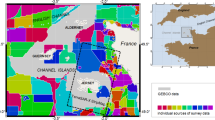Abstract
Under suitable conditions of tidal current and wind, underwater topography can be detected by synthetic aperture radar (SAR) indirectly. Underwater topography SAR imaging includes three physical processes: radar ocean surface backscattering, the modulation of sea surface short wave spectrum by the variations in sea surface currents, and the modulation of sea surface currents by the underwater topography. The first process is described usually by Bragg scattering theory because the incident angle of SAR is always between 20°–70°. The second process is described by the action balance equation. The third process is described by an ocean hydrodynamic model. Based on the SAR imaging mechanism for underwater topography, an underwater topography SAR detection model and a simplified method for its calculation are introduced. In the detection model, a two-dimensional hydrodynamic model — the shallow water model is used to describe the motion of tidal current. Due to the difficulty of determining the expression of SAR backscattering cross section in which some terms can not be determined, the backscattering cross section of SAR image used in the underwater topography SAR detection is pro-processed by the simulated SAR image of the coarse-grid water depth to simplify the calculation. Taiwan Shoal, located at the southwest outlet of Taiwan Strait, is selected as an evaluation area for this technique due to the occurrence of hundreds of sand waves. The underwater topography of Taiwan Shoal was detected by two scenes of ERS-2 SAR images which were acquired on 9 January 2000 and 6 June 2004. The detection results are compared with in situ measured water depths for three profiles. The average absolute and relative errors of the best detection result are 2.23 m and 7.5 %, respectively. These show that the detection model and the simplified method introduced in the paper is feasible.
Similar content being viewed by others
References
Alpers W, Hennings I. 1984. A theory of the imaging mechanism of underwater bottom topography by real and synthetic aperture radar. J. Geophys. Res., 89: 10 529–10 546.
Cooper A L, Chubb S R, Askari F et al. 1994. Radar surface signatures for the two-dimensional tidal circulation over Phelps Bank, Nantucket shoals: A comparison between theory and experiment. J. Geophys. Res., 99: 7 865–7 883.
Cushman-Roisin B. 1994. Introduction to Geophysical Fluid Dynamics. Prentice Hall, Upper Saddle River, New Jersey. 320p.
De Loor G P, Brunsveld van Hultan H W. 1978. Microwave measurements over the North Sea. Boundary Layer Meteorol., 13: 113–131.
Hennings I. 1990. Radar imaging of submarine sand waves in tidal channels. J. Geophys. Res., 95: 9 713–9 721.
Holliday D, St-Cyr G, Woods N E. 1986. A radar ocean imaging model for small to moderate incidence angles. Int. J. Remote Sens., 7: 1 809–1 834.
Hunghes B A. 1978. The effect of internal waves on surface wind waves. 2. Theoretical analysis. J. Geophys. Res., 83: 455–465.
Lyzenga D R, Bennett J R. 1988. Full-spectrum modeling of synthetic aperture radar internal wave signatures. J. Geophys. Res., 93: 12 345–12 354.
Ma Y, Zhang J. 2001. Simulation study of imaging of underwater bottom topography by Synthetic Aperture Radar. Journal of Hydrodynamics, (Ser. B) 3: 57–64.
Romeiser R, Alpers W. 1997b. An improved composite surface model for the radar backscattering cross section of the ocean surface. 2. Model response to surface roughness variations and the radar imaging of underwater bottom topography. J. Geophys. Res., 102: 25 51–25 267.
Romeiser R, Alpers W, Wismann V. 1997a. An improved composite surface model for the radar backscattering cross section of the ocean surface. 1. Theory of the model and optimization/validation by scatterometer data. J. Geophys. Res., 102: 25 230–25 250.
Shuchman R A, Lyzenga D R, Meadows G A. 1985. Synthetic aperture radar imaging of ocean bottom topography via tidal-current interactions: theory and observation. Int. J. Remote Sens., 6: 1 179–1 200.
Valenzuela G R. 1978. Theories for the interaction of electromagnetic and oceanic waves — a review. Boundary Layer Meteorol., 13: 61–85.
Valenzuela G R, Plant W J, Schuler D L et al. 1985. Microwave probing of shallow bottom topography in the Nantucket shoals. J. Geophys. Res., 90: 4 931–4 942.
Vogelzang J. 1989. The mapping of bottom topography with imaging radar: A comparison of the hydrodynamic modulation in some existing model. Int. J. Remote Sens., 10: 1 503–1 518.
Vogelzang J. 2001. A model comparison study to the imaging of submarine reefs with synthetic aperture radar. Int. J. Remote Sens. 22: 2 509–2 536.
Vogelzang J, Wensink G J, De Loor G P. 1992. Sea bottom topography with X-band SLAR: The relation between radar imagery and bathymetry. Int. J. Remote Sens., 13: 1 943–1 958.
Yang J G, Zhang J, Meng J M. 2006. Dependence of Underwater Bottom Topography Detection with SAR Image on Initial Water Depth. In: Proceedings of the Third International Symposium on Future Intelligent Earth Observing Satellites. Science Press, China. p. 599–602.
Yang J G, Zhang J, Meng J M. 2007. Underwater topography detection of Shuangzi Reefs with SAR images acquired in different time. Acta Oceanologica Sinica, 26: 48–54.
Yuan Y L. 1997. Representation of high frequency spectra of ocean waves and the basis for analyzing SAR images. Chin. J. Oceanol. Limnol., 28(suppl): 1–5.
Zheng Q, Li L, Guo X et al. 2006. SAR imaging and hydrodynamic analysis of ocean bottom topographic waves. J. Geophys. Res., 111, C09028, doi:10.1029/2006JC003586.
Author information
Authors and Affiliations
Corresponding author
Additional information
Supported by National Natural Science Foundation of China (Nos. 60672159 & 60890075), the State Oceanic Administration Marine Science Foundation for Youths (No.2009421), the Special Funds for Marine Commonweal Research (No. 200705027) and the Special Funds for Basic Scientific Research Project of the First Institute of Oceanography, S.O.A (No. 2008T29).
Rights and permissions
About this article
Cite this article
Yang, J., Zhang, J. & Meng, J. Underwater topography detection of Taiwan Shoal with SAR images. Chin. J. Ocean. Limnol. 28, 636–642 (2010). https://doi.org/10.1007/s00343-010-9070-x
Received:
Accepted:
Published:
Issue Date:
DOI: https://doi.org/10.1007/s00343-010-9070-x




